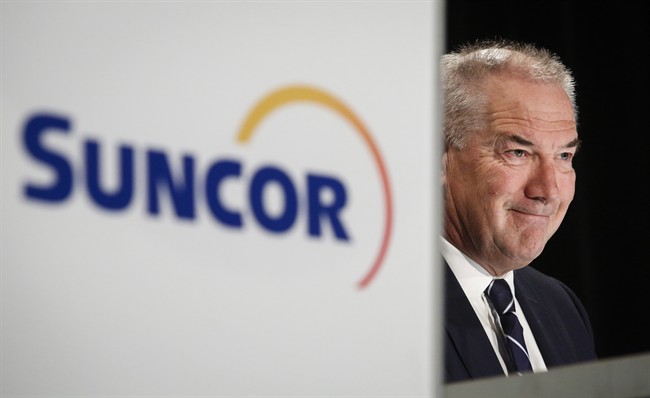CALGARY – The head of Suncor Energy is outlining a near-term future without major growth projects as Canada’s largest oilsands company focuses on lower costs and reducing its environmental footrprint.

CEO Steve Williams told investors at the company’s annual general meeting Thursday that Suncor is taking a more disciplined approach to growth, citing the deferral of projects like the MacKay River Expansion, a steam-driven oilsands development in northeastern Alberta, and the White Rose offshore oil extension off Newfoundland.
But he said the company is still pushing ahead with the $13-billion Fort Hills oilsands project that it half owns and the US$14-billion Hebron offshore project on the East Coast, in which it has a 21 per cent stake. Both are expected online by late 2017, but after that, Suncor expects to take a step back.
“We’ve got two major growth projects coming to a conclusion. It is difficult in the current economic environment to see how you would approve those types of projects,” said Williams in a conference call prior to the annual meeting.
“You will see us taking a breath around growth projects,” he added. “There isn’t a go back to how we were.”
READ MORE: Suncor to improve political lobbying, climate risk disclosure

Get weekly money news
After the meeting in Calgary, Williams said he doesn’t expect to make any big mine announcements for the next five to 10 years or even longer as the company looks to smaller-scale, steam-assisted developments known as in-situ projects.
Williams said Suncor could decide in 2018-19 on proceeding with some of those projects, which use pipes and steam to release oil from below ground. But the market is offering cheaper alternatives, he added.
“Right now I can buy on the market facilities that are operating for the same or less price than we could build ourselves,” said Williams.
The company announced late Wednesday that it was buying a five per cent additional stake in the Syncrude oilsands project for $937 million from Murphy Oil Corp., bringing Suncor’s stake to 54 per cent and adding 17,500 barrels a day of oilsands production.
READ MORE: Suncor increases stake in Syncrude oilsands project
The deal also gives Suncor majority control, but Williams said Suncor is in no rush to take over the operator’s role from Imperial Oil Resources.
Along with outlining its growth strategy at the meeting, Williams also emphasized the company’s environmental commitments.
“We at Suncor share the global challenge to tackle climate change head-on by reducing emissions and becoming what we call carbon competitive,” he said.
Suncor also endorsed a shareholder motion by NEI Investments that will have the company providing ongoing reports on how it’s assessing and ensuring its long-term resilience in a future low-carbon economy. The motion passed with more than 98 per cent in favour.
READ MORE: Shareholders press Suncor on climate policy and political lobbying
A second motion, advanced by campaign group Sum Of Us, called for greater disclosure of lobbying efforts and procedures. It failed, with 60 per cent of shareholders voting against it.
Williams said Suncor supported the spirit of the motion, but couldn’t back it because of technicality issues on disclosure.
Going forward, Williams said Suncor will continue to focus on lowering costs as it ramps up daily production from roughly 691,000 barrels of oil equivalent a day in the first quarter to in excess of 800,000 barrels in 2018 after Fort Hills and Hebron come online.
Overall, Suncor says it is targeting $500 million in savings this year, on top of the $1 billion in operational cost savings it achieved last year. It is also planning to sell off assets of between $1 billion and $1.5 billion in the next year.
Follow @ibickis on Twitter.







Comments